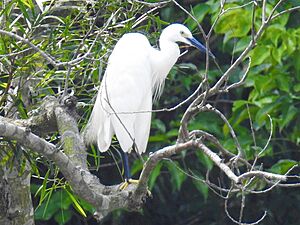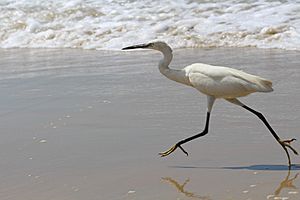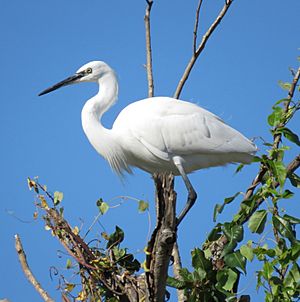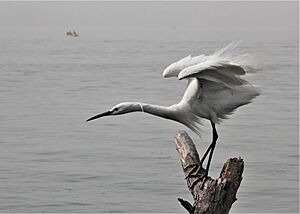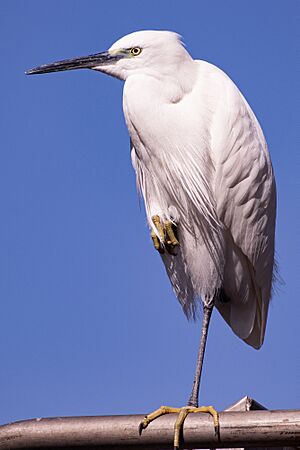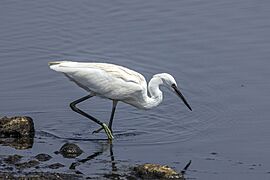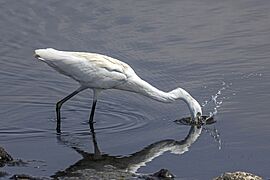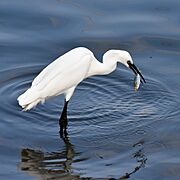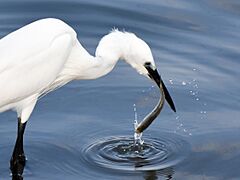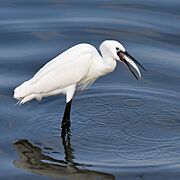Little egret facts for kids
Quick facts for kids Little egret |
|
|---|---|
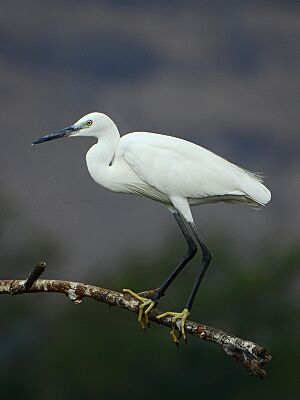 |
|
| E. g. garzetta | |
| Conservation status | |
| Scientific classification | |
| Genus: |
Egretta
|
| Species: |
garzetta
|
| Subspecies | |
|
E. g. garzetta |
|
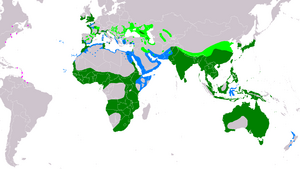 |
|
| Range of E. garzetta Breeding Resident Non-breeding Vagrant (seasonality uncertain) | |
The little egret (Egretta garzetta) is a small, white heron that belongs to the family Ardeidae. It has a thin black beak, long black legs, and bright yellow feet (in its western form).
This aquatic bird loves to feed in shallow water and on land. It eats many different small creatures. Little egrets often nest together in groups, sometimes with other water birds. They build platform nests from sticks in trees, bushes, or reed beds. A female egret usually lays three to five bluish-green eggs. Both parents take turns sitting on the eggs for about three weeks. The young birds are ready to fly and leave the nest when they are about six weeks old.
Little egrets live in wetlands in warm areas of Asia, Africa, Australia, and Europe. They have successfully spread their range northwards, and now healthy populations live in the United Kingdom.
In warmer places, most little egrets stay all year. However, egrets from northern areas, like many in Europe, migrate to Africa and southern Asia for the winter. Sometimes, these birds also travel north after the breeding season. This wandering habit has helped them spread to new places.
Long ago, little egrets were common in Western Europe. But in the 1800s, people hunted them a lot for their feathers, which were used to decorate hats. This caused them to disappear from some parts of northwestern Europe and become rare in the south. Around 1950, new laws were made in southern Europe to protect these birds, and their numbers started to grow again. By the early 2000s, little egrets were breeding once more in France, the Netherlands, Ireland, and Britain.
Their range continues to expand west. They have even started to appear in the New World. The first little egret was seen in Barbados in 1954, and they first bred there in 1994. The International Union for Conservation of Nature says that the little egret is a species of "least concern" because it is doing well globally.
Contents
Appearance and Sounds

Adult little egrets are about 55 to 65 centimeters (22 to 26 inches) long. Their wingspan can reach 88 to 106 centimeters (35 to 42 inches). They weigh between 350 and 550 grams (12 to 19 ounces). Most little egrets are completely white. However, some have darker, bluish-grey feathers.
During the breeding season, adult egrets grow two long feathers on the back of their head, forming a crest. These feathers are about 15 centimeters (6 inches) long and are very narrow. They also have special feathers on their chest and back that look long and loose. In winter, these special feathers are shorter.
The egret's beak is long and thin and is black. The skin around their eyes and at the base of their beak is greenish-grey, and their eyes have a yellow iris. Their legs are black, and their feet are yellow. Young egrets look similar to adults in winter, but their legs are greenish-black, and their feet are a duller yellow. Some might have grey or brownish feathers.
One type of little egret, called nigripes, has yellow skin between its beak and eye, and blackish feet. When egrets are ready to find a mate, the skin around their eyes can turn red, and the feet of the yellow-footed types can also turn red.
Little egrets are mostly quiet birds. But at their breeding colonies, they make different croaking and bubbling sounds. If they are disturbed, they make a harsh alarm call. Their calls sound very similar to those of the black-crowned night heron and the cattle egret, which they sometimes live near.
Where Little Egrets Live
The western type of little egret (E. g. garzetta) breeds in southern Europe, the Middle East, much of Africa, and southern Asia. Egrets from northern Europe fly to Africa for the winter, though some stay in southern Europe. Some Asian egrets migrate to the Philippines.
The eastern type (E. g. nigripes) lives in Indonesia and New Guinea. Another type, E. g. immaculata, lives in Australia and New Zealand, but does not breed in New Zealand.
In the late 1900s, the little egret's range grew northwards in Europe and spread to the New World. A group of egrets started breeding in Barbados in 1994. Since then, they have spread to other parts of the Caribbean and along the Atlantic coast of the United States.
Little egrets can live in many different places. They like the shores of lakes, rivers, canals, ponds, and marshes. They prefer open areas rather than thick bushes. Along the coast, they live in mangrove areas, swamps, mudflats, sandy beaches, and reefs. Rice fields are also important homes for them in Italy. In Africa, coastal and mangrove areas are key habitats. These birds often walk around near cattle or other animals with hooves.
Behavior and Diet
Little egrets are social birds and are often seen in small groups. However, when they are feeding, individual birds usually don't let others get too close to their chosen spot. This can depend on how much food is available.
How Little Egrets Find Food
Little egrets use many different ways to catch their food. They might quietly walk through shallow water, sometimes running with their wings raised or shuffling their feet to scare small fish. Or, they might stand very still and wait to surprise their prey. They also take advantage of opportunities, like when cormorants disturb fish or when people throw bread into the water.
On land, they walk or run while chasing their prey. They also eat creatures that are disturbed by grazing livestock and even pick ticks off the animals. Sometimes, they will even scavenge for food. Their main food is fish, but they also eat amphibians, small reptiles, small mammals, and even small birds. They also enjoy crustaceans (like crabs), molluscs (like snails), insects, spiders, and worms.
Reproduction and Life Cycle
Little egrets build their nests in colonies, often with other wading birds. In some parts of western India, these colonies can be found in cities. Other birds that might nest with them include cattle egrets, black-crowned night herons, and black-headed ibises. In Europe, they might nest with squacco herons, cattle egrets, black-crowned night herons, and glossy ibises.
Their nests are usually platforms made of sticks. They build them in trees, shrubs, reed beds, or bamboo groves. In some places, like the Cape Verde Islands, they even nest on cliffs. Each pair of egrets protects a small area around their nest, usually about 3 to 4 meters (10 to 13 feet) wide.
The female lays three to five eggs. Both parents take turns sitting on the eggs for 21 to 25 days until they hatch. The eggs are oval-shaped and have a pale, dull, blue-green color. When the young birds hatch, they are covered in soft white down feathers. Both parents care for them, and the young egrets are ready to fly after 40 to 45 days.
Conservation Efforts
Around the world, the little egret is not considered a threatened species. In fact, its population has grown and spread to new areas over the past few decades. The International Union for Conservation of Nature says that because they are found in so many places and have a large total population, they are a species of "least concern".
Little Egrets in Europe
Long ago, little egrets were common in Ireland and Great Britain. But they disappeared from these areas because of too much hunting in the late medieval period and changes in the climate at the start of the Little Ice Age. For example, at a big feast in 1465, 1,000 egrets were served, showing that many lived in northern England back then. By the mid-1500s, they were already becoming rare.
Their numbers continued to drop across Europe because their beautiful plumes were in high demand for decorating hats. This "plume trade" became very popular in the 1800s, and millions of egret skins were sold. In just three months of 1885, 750,000 egret skins were sold in London! This hunting reduced the egret population to very low levels. This problem led to the creation of Britain's Royal Society for the Protection of Birds in 1889, which aimed to protect birds.
By the 1950s, little egrets were mostly found only in southern Europe. New laws were then put in place to protect them. This helped their population grow strongly. Over the next few decades, they became more common in western France and then along the northern coast. They started breeding in the Netherlands in 1979. Today, about 22,700 pairs are thought to breed in Europe. Their populations are stable or growing in Spain, France, and Italy, but decreasing in Greece.
In Britain, the little egret was a rare visitor from the 1500s until the late 1900s. It did not breed there. However, it has recently become a regular breeding bird and is now often seen in large numbers along the coast. The first recent breeding record in England was in 1996 on Brownsea Island in Dorset. They first bred in Wales in 2002. Since then, their population has grown quickly. In 2008, over 750 pairs were breeding in nearly 70 colonies. The first breeding record in Scotland was in 2020. In Ireland, they first bred in 1997 in County Cork, and their population has also expanded rapidly since then. Even harsh winters in 2010–2012 were only a temporary setback, and the species continues to spread.
Little Egrets in Australia
In Australia, the little egret's status varies by state. In Victoria, it is listed as "Threatened" under the Flora and Fauna Guarantee Act 1988. This means there is a plan to help this species recover and manage its future. On the 2007 list of threatened animals in Victoria, the little egret is listed as endangered.
Little Egrets in the New World
As their range continues to grow, little egrets have started to live in the New World (the Americas). The first time one was seen there was in Barbados in April 1954. The birds began breeding on the island in 1994 and now also breed in the Bahamas. They might have flown across the Atlantic Ocean from Western Africa. Ringed birds from Spain suggest where some of these birds came from.
Little egrets look very similar to the snowy egret. They share nesting sites with snowy egrets in Barbados, where both are relatively new arrivals. Little egrets are larger and use more different ways to find food. They also tend to be dominant over feeding spots.
Little egrets are being seen more often in a wider area of the Americas. They have been observed from Suriname and Brazil in the south, all the way to Newfoundland, Quebec, and Ontario in the north. Birds on the east coast of North America are thought to have moved north with snowy egrets from the Caribbean. In June 2011, a little egret was spotted in Maine, in the Scarborough Marsh.
Images for kids
See also
 In Spanish: Garceta común para niños
In Spanish: Garceta común para niños



